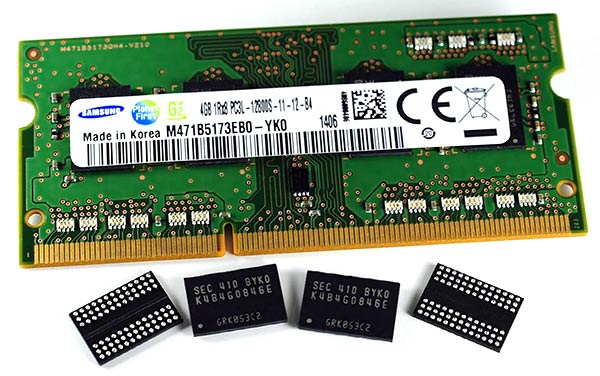Samsung today announced that it has started mass production of 4-gigabit (Gb) DDR3 DRAM on the industry's most advanced 20 nanometre (nm) process. The South Korean tech giant said it had "pushed the envelope of DRAM scaling, while utilizing currently available immersion ArF lithography," in order to produce its new chips.
We are informed that SRAM miniaturisation is more difficult than for NAND memory as DRAM cells require both a capacitor and transistor linked to one another while NAND solely requires a transistor. However Samsung overcame the challenge by refining its design and manufacturing technologies resulting in a modified double patterning and atomic layer deposition technique which enabled the 20nm DDR3 production milestone to be achieved. It is using this technology that Samsung asserts it will move to 10nm class (somewhere between 10 and 20 nanometres) DRAM production.

"Samsung's new energy-efficient 20-nanometer DDR3 DRAM will rapidly expand its market base throughout the IT industry including the PC and mobile markets, quickly moving to mainstream status," said Young-Hyun Jun, executive vice president, memory sales and marketing at Samsung Electronics. "Samsung will continue to deliver next-generation DRAM and green memory solutions ahead of the competition, while contributing to the growth of the global IT market in close cooperation with our major customers."
The benefits of the new 20nm 4Gb DDR3 based modules are said to include both higher cell performance and energy consumption reductions. While Samsung doesn't quantify the performance bump in any way it mentions that its new 20nm modules can "save up to 25 per cent of the energy consumed by equivalent modules fabricated using the previous 25 nanometre process technology". Another positive for Samsung is that its manufacturing productivity is "over 30 percent higher than that of the preceding 25 nanometre DDR3, and more than twice that of 30nm-class DDR3".
Better performance and lower energy use sounds doubly good and hopefully some of Samsung's savings, thanks to its increased manufacturing productivity, can be passed onto end users.













